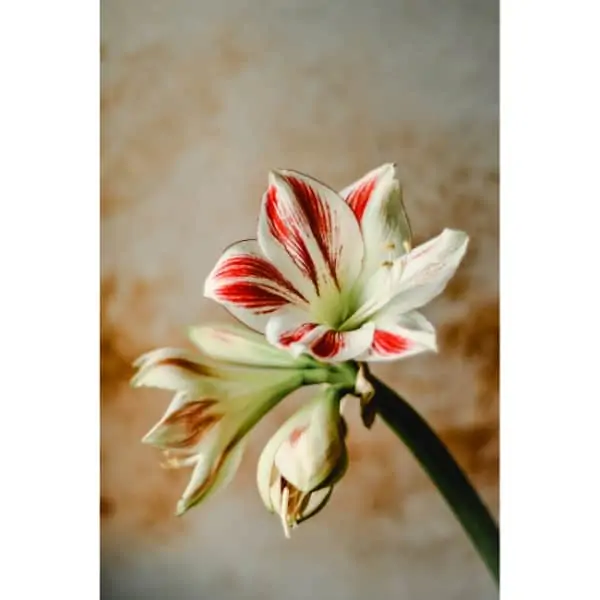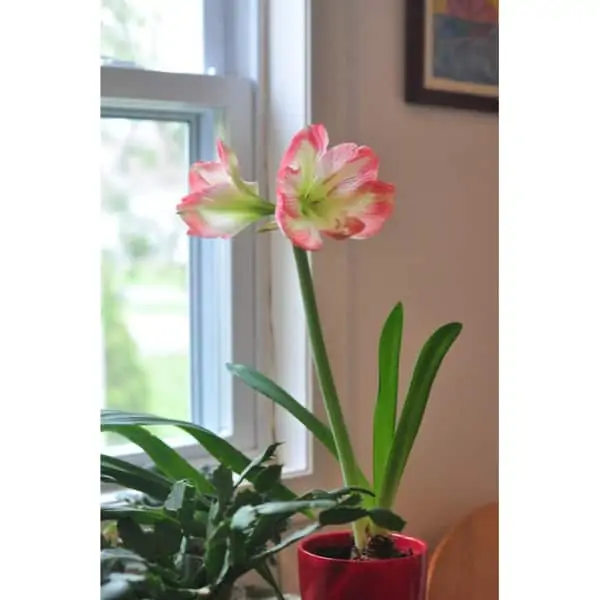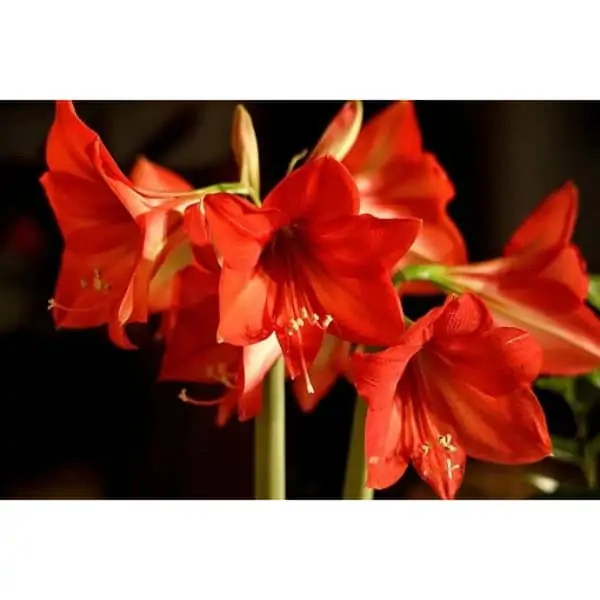Amaryllis Care Guide For Fresh Flowers All Year Round
Have a look at our complete Amaryllis care guide! Find tips, tricks and useful info on how to make sure your plant blooms again and again!
Amaryllis Care: About Amaryllis
From a little bulb, half-buried in an unassuming pot, grows a thick, light green stem. It towers over the pot and its leaves, rising to incredible heights. Hard to believe it started from that tiny bulb just weeks ago! The top of the stem is adorned with a crown of flowers, white, speckled with red, wide open. They cluster together to form a round bunch of small, single flowers that give off a sweet smell. The shy winter sun caresses the few leaves the flower has, as its brown turns to the light and away from the darkness behind it.
In more plain terms, an amaryllis plant is flowering in the corner near a window, in the middle of winter. There is nothing special about this, after all, amaryllis is one of the showiest plants that flowers in winter, and it can be grown outside in zones 8 and up. Here are tips and tricks on how to make it flower when you want and get the most of your amaryllis plant!
Amaryllis Care Guide
Water
The basic rule of thumb when growing amaryllis is “some but not too much”. This applies to water as well as the other needs. Keep the soil moist, but not soaking wet, and when storing, allow the bulbs to dry out completely. Amaryllis doesn’t need misting, not does it need much humidity. Just water once or twice a week, depending on the size of the pot, and you’re all good.
Light
Amaryllis needs plenty of light to grow. Decide if it needs direct sun or bright, indirect light, judging by the temperature and weather. Do not expose it to the mid-day sun in zone 10, but don’t give it indirect light in zone 3 either. Your aim is to maintain a balance between how much light it needs and how hot it can get! When storing, keep away from any source of light.
Temperature
This plant is easiest to keep indoors, so indoor temperatures should be fine. Make sure you don’t let the sun scorch the leaves or the temperature get over 90°F (32°C), or under 68°F (20°C). Also, keep the flower away from heating vents or direct air conditioning. When resting, the bulb will need the temperature to be around a stable 59°F (15°C), away from drafts or humidity.
Soil
Amaryllis does not really need soil, only support. You can plant it in pebbles, as long as there is enough water to feed it. If you want your amaryllis to bloom again and again, do plant it in soil though. Without soil, the plant will eventually eat through its resources in the bulb, and it will wilt. So while it looks great to plant amaryllis in pebbles, potting mix is actually better. Choose a well-draining potting soil that is also rich in organic material.
Fertilization
To keep your amaryllis blooming and to ensure the biggest flowers, you can use some organic fertilizer no earlier than a month after you started growing it. With fertilization, you can get an impressive amount of flowers in one go, and you can even try to push for two blooms in one growing cycle. Use a liquid fertilizer in small quantities to make sure you don’t burn roots or the bulb itself. Alternatively, you can use slow-release pellets, but they might not melt in time.
Pruning
Deadhead dried flowers to maintain the remaining ones. Once the flowering process is finished and all the flowers are dried, cut off the flower stem and put the pot in a cool, dark place, away from humidity. Stop watering and start cutting off leaves as they dry off. You can, of course, prune away leaves that get in the way or that have defects. Be careful how you dispose of the leaves and stems, especially if you have pets because amaryllis is toxic to pets.
Amaryllis Care Summary
Water
Keep soil moistLight
Full sun to bright indirectTemperature
68-90°F (20-32°C)Soil
Rich, well drainingToxicity
Toxic to petsDifficulty
EasyAmaryllis Care: What To Do Next
Let’s address the “how to make amaryllis bloom when you want”. The process has to start about a month before you need the blooms. So if you want your plant in full bloom for Christmas, mid to late-November is the best time to start. Take the bulbs out of storage, place them in fresh pots of soil, in indirect light, and lightly water. Once the leaves or stem start growing, move the pot closer to a window if you think it’s needed, and water once a week. In about a month, you should have flowers. Once the flowers are dried and the stem is cut off, remove the bulb from the pot and place it in storage, so it can rest before you have the next set of flowers.
Next, here are some ideas about amaryllis! You can combine multiple kinds of bulbs in a wide planter, to get a mix of different colored flowers. They come in warm colors, from white to red, going through pinks and oranges. Once in bloom, you can give them as presents that last a long time and can bloom multiple times. Alternatively, you can cut off the flowers and keep them as cut flowers in a vase. If you do this, you could convince the bulb to bloom again in the same life cycle.
And one last piece of advice: keep an eye on plant diseases, because amaryllis is prone to root rot and a good host for various kinds of pests. Fortunately, you have the rest period, when you will get rid of most pests. And for everything else, there is insecticidal soap or neem oil!
Final Thoughts
Now you have a handy amaryllis care guide to use and give whenever you need it! Grow your amaryllis to be ready when you need it and give it as a gift or use it as decoration for yourself. Let me know how your flowers are doing and what you are going to use them for in the comments section below! Happy gardening and may the leaves be always in your favor!






